

 Because tobacco originated from the new
world, it only reached China around the end of the XVI th century,
most probably introduced by Portugeses tradesmen and Jésuit
missionaries.
Due to a different climat and to a high
level of humidity in the air, snuff boxes imported from the East no
longer fulfiled their initial functions of air/watertightness and
were therefore abandoned.
At that time, small bottles ended in an
air/watertight stopper were used in China in order to keep and
preserve medicinal herbs. The idea occured to use them as snuff
bottles.
They usually come in the shape of little
bottles 7 to 8 centimetres high and 4 to 5 cm wide. They are equipped
with fine curettes in extension of the stopper in order to enable the
extraction of the powder.
Because tobacco originated from the new
world, it only reached China around the end of the XVI th century,
most probably introduced by Portugeses tradesmen and Jésuit
missionaries.
Due to a different climat and to a high
level of humidity in the air, snuff boxes imported from the East no
longer fulfiled their initial functions of air/watertightness and
were therefore abandoned.
At that time, small bottles ended in an
air/watertight stopper were used in China in order to keep and
preserve medicinal herbs. The idea occured to use them as snuff
bottles.
They usually come in the shape of little
bottles 7 to 8 centimetres high and 4 to 5 cm wide. They are equipped
with fine curettes in extension of the stopper in order to enable the
extraction of the powder.
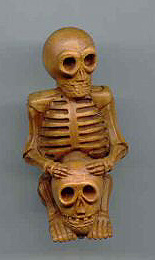 *
*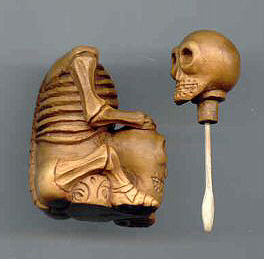 Box wood skeleton with example of
curette
Traditionnally Chinese people carried
them tied to their belt in a little silk pouch.
After having been banned, as in numerous
other European countries, tobacco was re-introduced in China around
1644 under the Qing dynasty. Snuff taking is rapidly going to be a
must at the imperial court but also in the upper social classes
before reaching the whole country during the XVIII th century. The
emperor Qianlong was himself really keen on snuff taking like as his
prime minister Ho Sen, who, as it is said, owed over 3000 snuff boxes
!
Box wood skeleton with example of
curette
Traditionnally Chinese people carried
them tied to their belt in a little silk pouch.
After having been banned, as in numerous
other European countries, tobacco was re-introduced in China around
1644 under the Qing dynasty. Snuff taking is rapidly going to be a
must at the imperial court but also in the upper social classes
before reaching the whole country during the XVIII th century. The
emperor Qianlong was himself really keen on snuff taking like as his
prime minister Ho Sen, who, as it is said, owed over 3000 snuff boxes
!
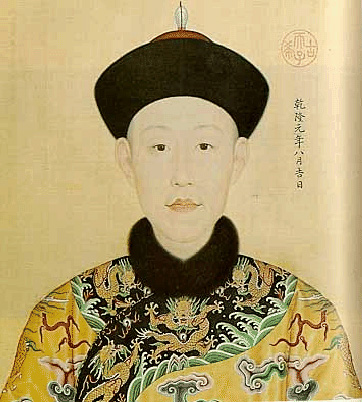 Emperor Qianlong, Qing
dynasty
Superb snuffboxes in Pekin glass, jade,
red coral, china, ivory, amber, lacquer etc... were manufactured
during that period.
Emperor Qianlong, Qing
dynasty
Superb snuffboxes in Pekin glass, jade,
red coral, china, ivory, amber, lacquer etc... were manufactured
during that period.
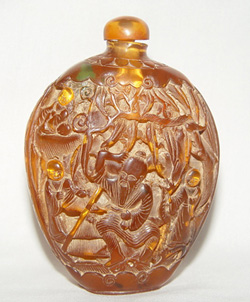 *
*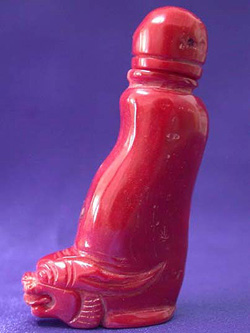 *
*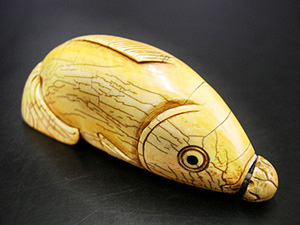 Ambre / Corail rouge /
Ivory
The ones made of metal generally came
from Tibet :
Ambre / Corail rouge /
Ivory
The ones made of metal generally came
from Tibet :
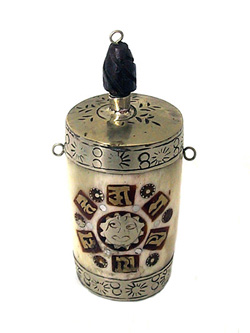 Bone and silver coloured
metal
Bone and silver coloured
metal
Snuff boxes painted from the
inside:
Snuff boxes were sculpted, others painted
and around 1795, the first snuff boxes painted from the inside
appeared: a real technical feat showing the craftman's dexterity,
patience and rigour. (see here below an exemple of a pekin glass
snuff box painted from the inside. )
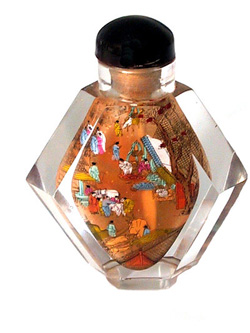 A popular story relates its
origin:
During the Qing dynasty (1644-1911) an
official who was keen on snuff taking decided to stop on his way in a
temple in order to have a rest . When he took his crystal snuff
bottle, he noticed that it was empty. He scratched some tabacco stuck
on the inside of his bottle with a sharp bamboo stem, which left some
visible marks. A young monk saw him doing it and got the idea to
paint snuff bottles from the inside.
During the manufacturing of such a snuff
bottle, the generally smooth inside wouldn't allow the paint to
remain on the surface, and the idea occured to insert sand and iron
granules. Then the snuff bottle was energetically shaken in order to
get a rough surface for the paint.
The accomplished craftman could then
create in such a small place all the most popular and traditional
Chinese themes: characters, landscapes, flowers, birds, calligraphy
and create works of art.
To do so, he used to introduce in the
tight neck of the snuff bottle, a small piece of bamboo not bigger
than a match but much longer with an end in the shape of a
hook.
Soaked in coloured ink and driven into
the bottle, the point in the shape of a hook enabled the craftman to
create his picture in two main phases: he started by drawing the main
details and finished with the background. Exactly the opposite of a
normal painting !
Unfortunately it was rapidly noticed that
the rough internal part also retained the powder and the use of this
type of snuff bottle came to an end. Snuff bottles painted from the
inside became afterwards well appreciated as a collector's item but
also as a new support for painting.
Other types of snuff bottles kept on
being manufactured and used at least until the end of the Qing
dynasty in 1911 when their use came to an end with the arrival of the
cigarettes.
List of the major
dynasties:
Qin
Dynasty: 221-207 BC
Han
Dynasty: 206 BC-220 AD
Three
Kingdoms: 220-280
Period of
Disunion: 281-617
Tang
Dynasty: 618-907
Five
Dynasties: 908-960
Song
Dynasty: 960-1279
Yuan
Dynasty: 1279-1368
Ming
Dynasty: 1368-1644
Qing
Dynasty: 1644-1911
Pictures taken at the American Museum of
Natural History / New York City:
Snuff bottles
A popular story relates its
origin:
During the Qing dynasty (1644-1911) an
official who was keen on snuff taking decided to stop on his way in a
temple in order to have a rest . When he took his crystal snuff
bottle, he noticed that it was empty. He scratched some tabacco stuck
on the inside of his bottle with a sharp bamboo stem, which left some
visible marks. A young monk saw him doing it and got the idea to
paint snuff bottles from the inside.
During the manufacturing of such a snuff
bottle, the generally smooth inside wouldn't allow the paint to
remain on the surface, and the idea occured to insert sand and iron
granules. Then the snuff bottle was energetically shaken in order to
get a rough surface for the paint.
The accomplished craftman could then
create in such a small place all the most popular and traditional
Chinese themes: characters, landscapes, flowers, birds, calligraphy
and create works of art.
To do so, he used to introduce in the
tight neck of the snuff bottle, a small piece of bamboo not bigger
than a match but much longer with an end in the shape of a
hook.
Soaked in coloured ink and driven into
the bottle, the point in the shape of a hook enabled the craftman to
create his picture in two main phases: he started by drawing the main
details and finished with the background. Exactly the opposite of a
normal painting !
Unfortunately it was rapidly noticed that
the rough internal part also retained the powder and the use of this
type of snuff bottle came to an end. Snuff bottles painted from the
inside became afterwards well appreciated as a collector's item but
also as a new support for painting.
Other types of snuff bottles kept on
being manufactured and used at least until the end of the Qing
dynasty in 1911 when their use came to an end with the arrival of the
cigarettes.
List of the major
dynasties:
Qin
Dynasty: 221-207 BC
Han
Dynasty: 206 BC-220 AD
Three
Kingdoms: 220-280
Period of
Disunion: 281-617
Tang
Dynasty: 618-907
Five
Dynasties: 908-960
Song
Dynasty: 960-1279
Yuan
Dynasty: 1279-1368
Ming
Dynasty: 1368-1644
Qing
Dynasty: 1644-1911
Pictures taken at the American Museum of
Natural History / New York City:
Snuff bottles
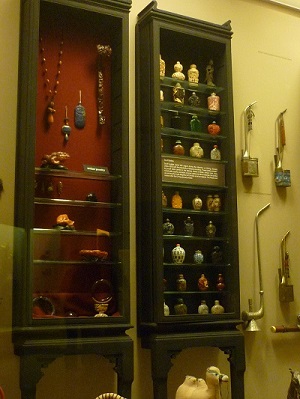 *
*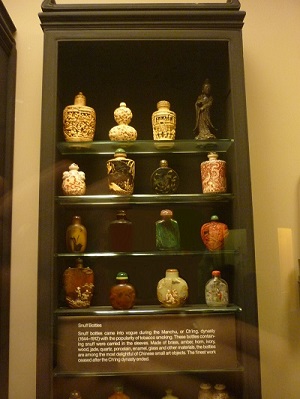 *
*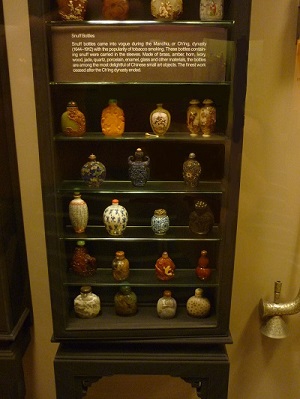






 *
* *
*
 *
* *
*